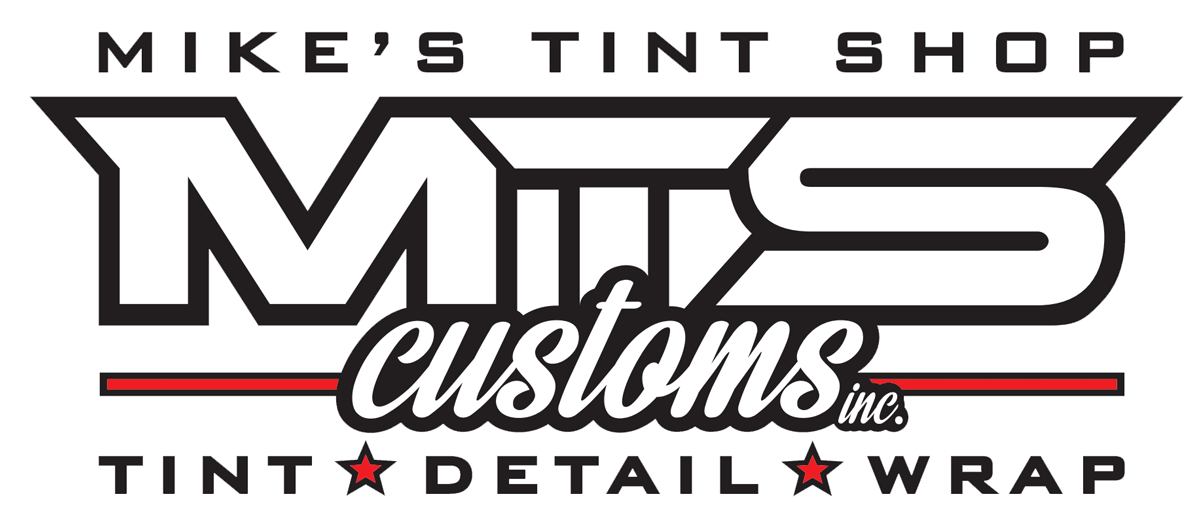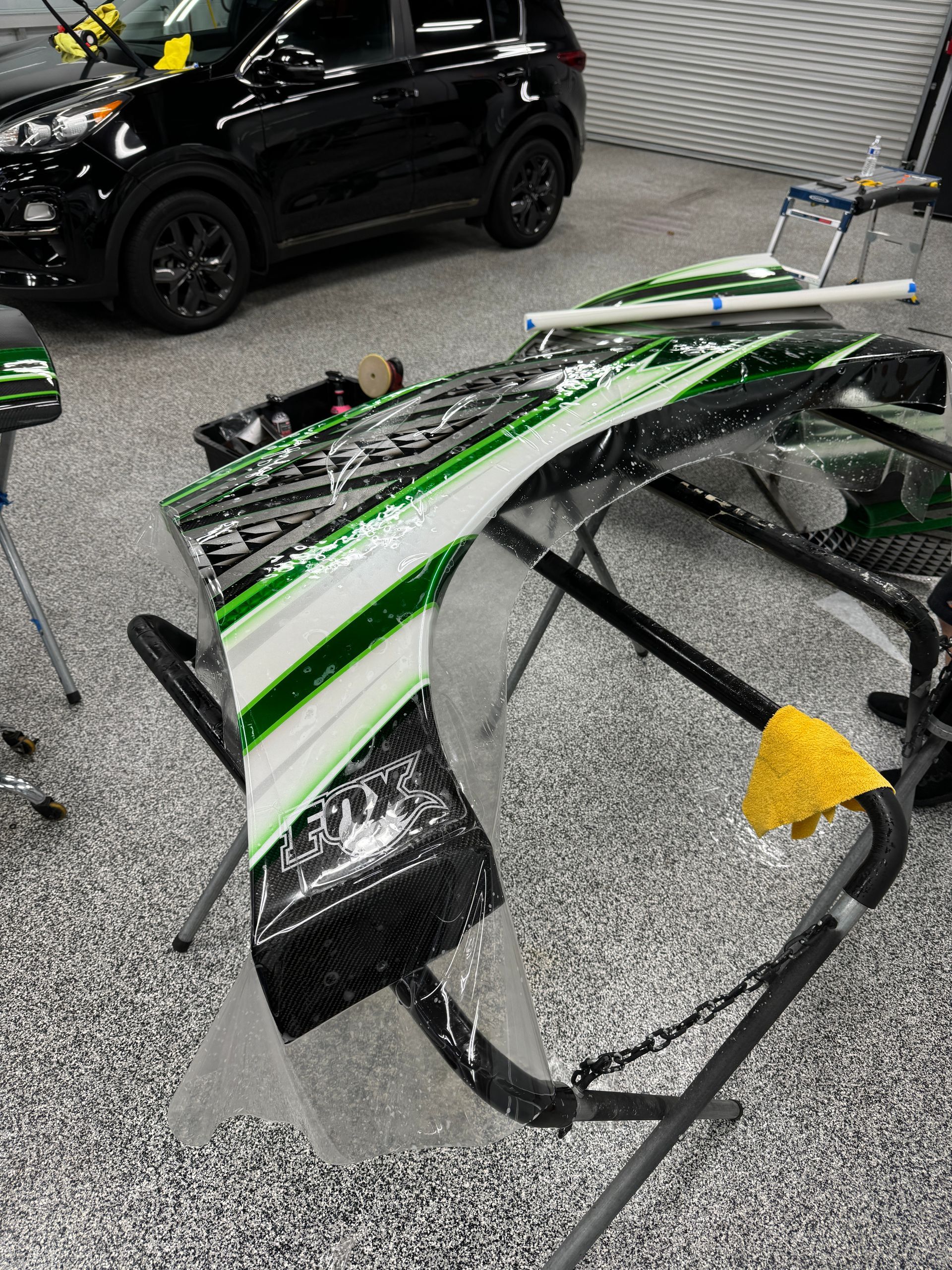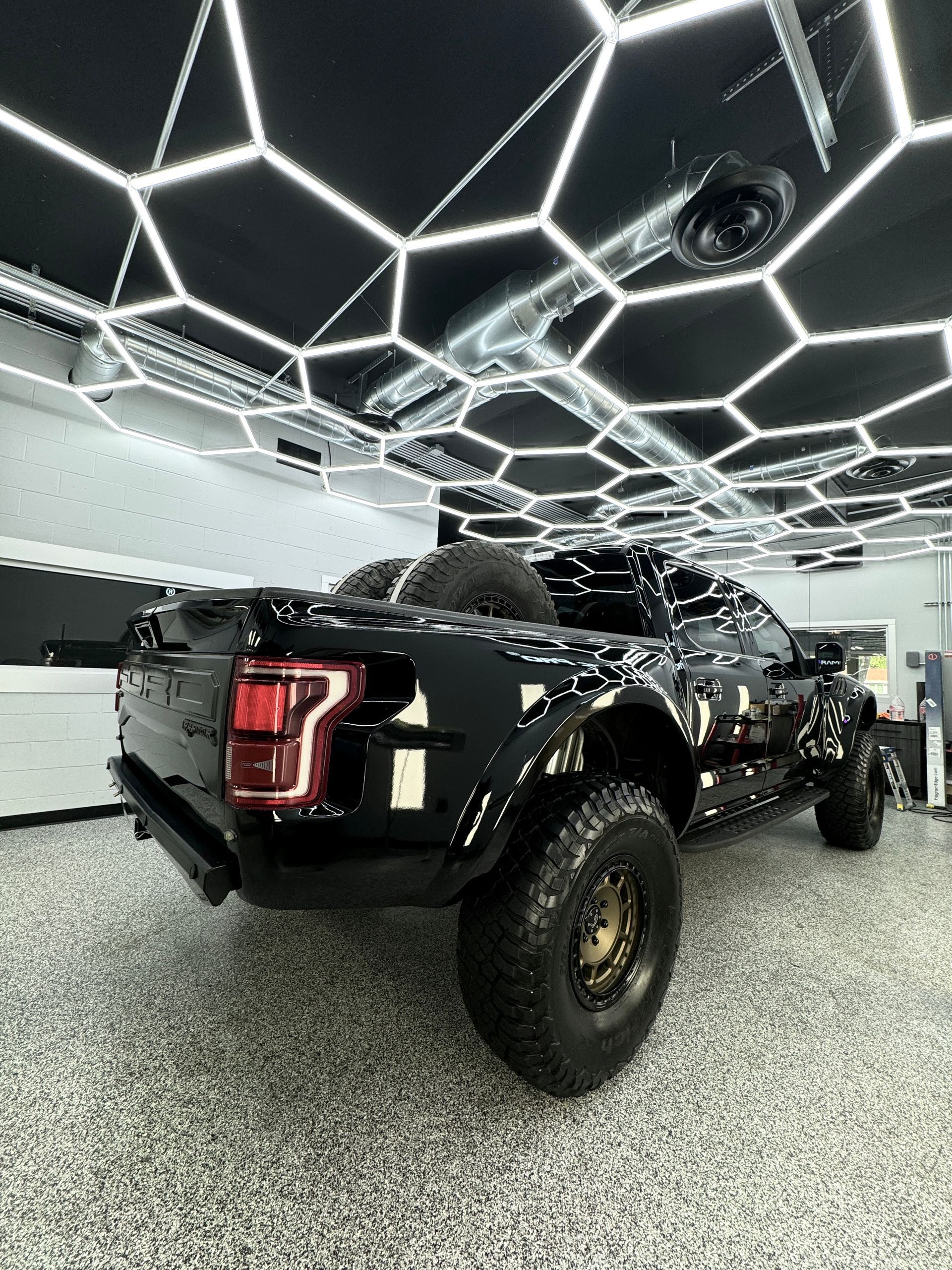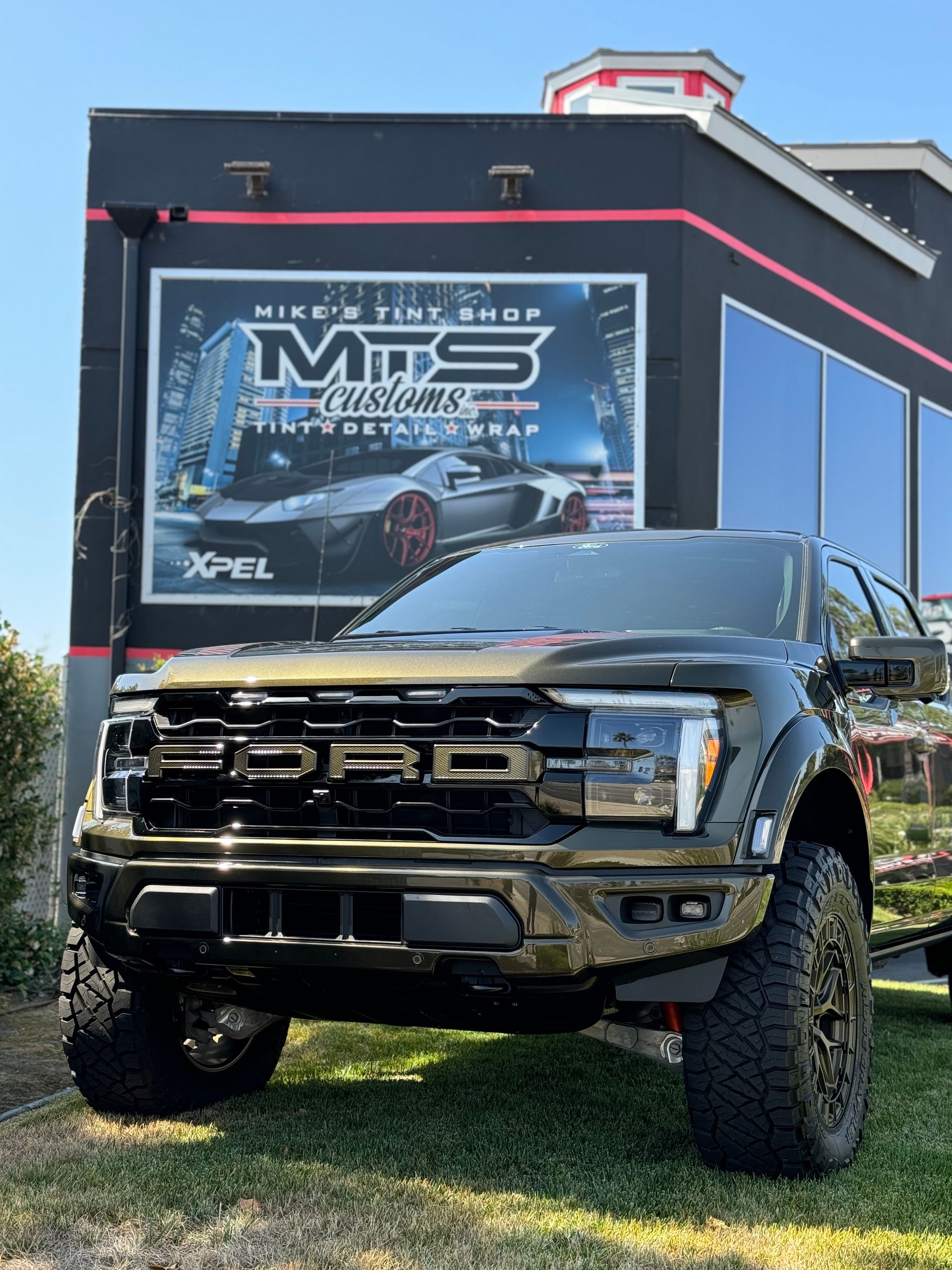5 STAR QUALITY SERVICE
Solvent-Based vs Water-Based Ceramic Coatings: Complete Comparison Guide
Choosing the right ceramic coating for your car can feel like a tough call—there are so many options, and it’s hard to know which one really fits your needs. Should you go for the strong, long-lasting protection of solvent-based coatings, or the easier, safer-to-use water-based kinds? After working with both types and hearing from car owners at Mike’s Tint Shop, I’ve put together everything you need to understand the key differences. This guide will help you pick what works best for your ride, whether you want top-tier toughness or something more user-friendly.
Solvent-based
ceramic coatings typically offer stronger chemical bonding and longer durability but emit stronger odors and require better ventilation during application. In contrast, water-based ceramic coatings are more user-friendly with lower toxicity, faster drying times, and easier cleanup, making them ideal for DIY enthusiasts or use in confined spaces.
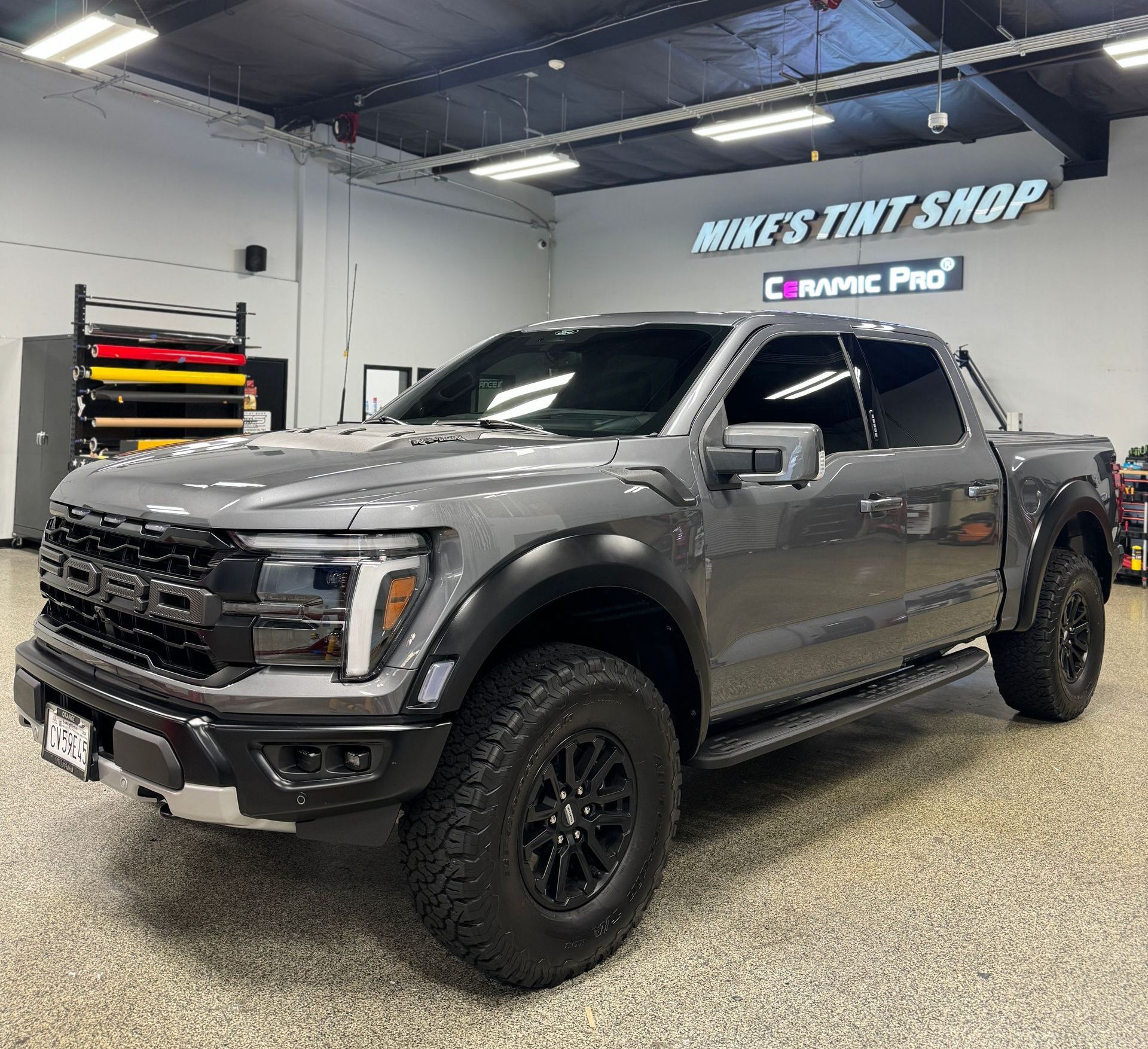
Comparing Solvent-Based and Water-Based Ceramic Coatings
At the heart of this choice lies the difference in their chemical makeup: solvent-based coatings use chemical solvents to carry the resin, while water-based coatings rely primarily on water as their carrier. This seemingly simple distinction carries a cascade of consequences for how these coatings behave, how easy they are to apply, and the environmental impact they leave behind.
Take drying and curing times, for example. Solvent-based coatings tend to dry faster—often within 12 to 24 hours—because their solvents evaporate quickly. This swift drying results in a more robust chemical bond with your vehicle’s surface, giving you a coating that can typically handle harsher weather conditions, UV rays, and chemicals with less degradation over time. However, that speed comes with a cost: proper ventilation during application is crucial to avoid inhaling potentially harmful fumes. The strong odor warnings aren’t just marketing—they reflect real health considerations.
By contrast, water-based coatings cure more slowly, often drying fully within 6 to 12 hours but are much more sensitive to humidity levels. Too much moisture in the air can slow down curing or even affect how well the coating bonds. However, their gentler formula means they emit far fewer volatile organic compounds (VOCs)—often less than 50 grams per liter compared to hundreds in solvent types—which makes them especially attractive for hobbyists working in enclosed spaces or anyone concerned about environmental impact and personal safety.
Another practical point: ease of application. If you’re new to ceramic coatings or prefer DIY projects without specialized protective gear, water-based products usually win on convenience. Their lower toxicity and subdued odor allow for more relaxed working conditions, whereas solvent-based coatings often require respirators or industrial-grade masks, as well as dedicated ventilation setups.
Durability-wise, solvent-based coatings often hold an edge due to their hardness ratings (commonly reaching up to a 10H on the Mohs scale), meaning they can resist scratches and wear more effectively than many water-based alternatives that tend toward 7H-9H. This difference means solvent-based coatings typically offer a longer lifespan on your vehicle’s surface before needing reapplication or maintenance. But durability isn’t everything; water-based options still deliver excellent protection and are frequently chosen because they strike a balance between performance and user-friendliness.
| Feature | Solvent-Based Coatings | Water-Based Coatings |
|---|---|---|
| Composition | Chemical solvents as carriers | Water as carrier |
| VOC Emissions | High (400-600 g/L) | Low (<50 g/L) |
| Drying Time | Fast (12-24 hrs) | Moderate (6-12 hrs), humidity-sensitive |
| Application | Requires ventilation and PPE | Safer for indoor & DIY use |
| Durability | Very high (9H-10H hardness) | Good (7H-9H hardness) |
| Odor | Strong chemical smell | Minimal |
Understanding these trade-offs helps make an informed decision based on what really matters for your situation—whether that’s maximum protection for a show car or a safer, easier application for at-home detailing enthusiasts.
Examining these characteristics sets the stage for exploring why certain users might prefer the advantages offered by solvent-based formulations under specific conditions. Next, we investigate the distinct benefits driving the popularity of these options in professional settings.
Benefits of Solvent-Based Options
Solvent-based ceramic coatings stand out because they form an incredibly strong chemical bond with your vehicle’s paint surface. This bond translates into a harder, more durable finish that can withstand everything from acidic rain and salt spray to harsh cleaning chemicals.
For anyone who spends time driving in varied or challenging environments, this kind of resilience means longer-lasting protection without frequent reapplications. In practical terms, many solvent-based coatings provide durability in the range of three to five years—sometimes even longer under ideal conditions—which is substantially more than typical water-based products.
One critical advantage that might not be immediately obvious is that these coatings cure through a process involving oxygen-driven chemical reactions rather than just evaporation of water. This makes them less sensitive to environmental factors like humidity, allowing them to harden evenly and maintain their protective qualities regardless of slight variations in weather during application.
If you live somewhere with fluctuating climate conditions, tackling such a coating can give you peace of mind that the finish will hold up.
However, this strength does come with some trade-offs. Because solvent-based coatings rely on potent chemical solvents as carriers, applying them requires good ventilation and protective measures for health safety reasons. These fumes contain higher levels of volatile organic compounds (VOCs), which elevate health concerns if someone applies them in poorly ventilated spaces.
That’s why we often recommend professional application or, at minimum, using proper respiratory equipment and working outdoors or in a well-ventilated garage.
Beyond durability and chemical resistance, solvent-based coatings also tend to produce a more visually striking finish with higher gloss retention over time. Their harder surface offers excellent resistance against scratching and etching caused by everyday wear—from road debris to washing tools.
This means your car isn’t just protected; it stays looking sleek and showroom-ready for longer periods without the need for constant upkeep sprays or polishing.
Here are some additional advantages that draw many enthusiasts and professionals towards solvent-based ceramic coatings:
- Wider application temperature range: They cure effectively between -5°C to 35°C, accommodating colder or hotter conditions.
- Stronger pH resistance: Effective against acidic and alkaline contaminants across a wide pH spectrum (2–12), making them robust against environmental pollutants.
- Long-term cost-effectiveness: Though upfront costs and labor may be higher, fewer reapplications reduce maintenance demands over time.
- Hardness rating: Achieving about 9H on the pencil hardness scale, they provide one of the toughest surfaces available for paint protection.
| Attribute | Solvent-Based Coatings | Water-Based Coatings |
|---|---|---|
| Durability | 3-5 years | 1-3 years |
| VOC Content | High (400–600 g/L) | Low (<100 g/L) |
| Hardness Rating | ~9H (higher scratch resistance) | 7H–8H |
| Curing Time | 12–24 hours | 6–12 hours |
| Temperature Range | -5°C to 35°C | 5°C to 30°C |
| Chemical Resistance | Broad pH 2–12 | Narrower pH range 4–10 |
| Gloss Retention (12 mo) | ~85% | ~70% |
As you weigh these benefits, consider your own use case carefully. If you're looking for maximum protection and longevity—and have access to professional tools or skilled technicians—a solvent-based ceramic coating is often worth the investment.
To get expert advice tailored for your vehicle type or local environment, reach out to trusted specialists like those at Mike's Tint Shop. They combine deep knowledge of automotive finishes with experience applying both coating types safely and effectively.
Remember: while what lies beneath the clear coat matters most, the application process is equally critical for solvent-based products due to their chemical profile. A conscientious approach during installation helps unlock their full potential while safeguarding both your car’s finish and your wellbeing.
With all these strengths laid out clearly, it’s easy to appreciate why professionals often turn toward solvent-based coatings despite their challenges—especially when long-lasting beauty and protection are non-negotiable.
Exploring these points opens the door to understanding why water-based alternatives have gained traction in different contexts. Let’s now turn attention to how these solutions address specific needs related to safety, environmental impact, and user-friendliness.
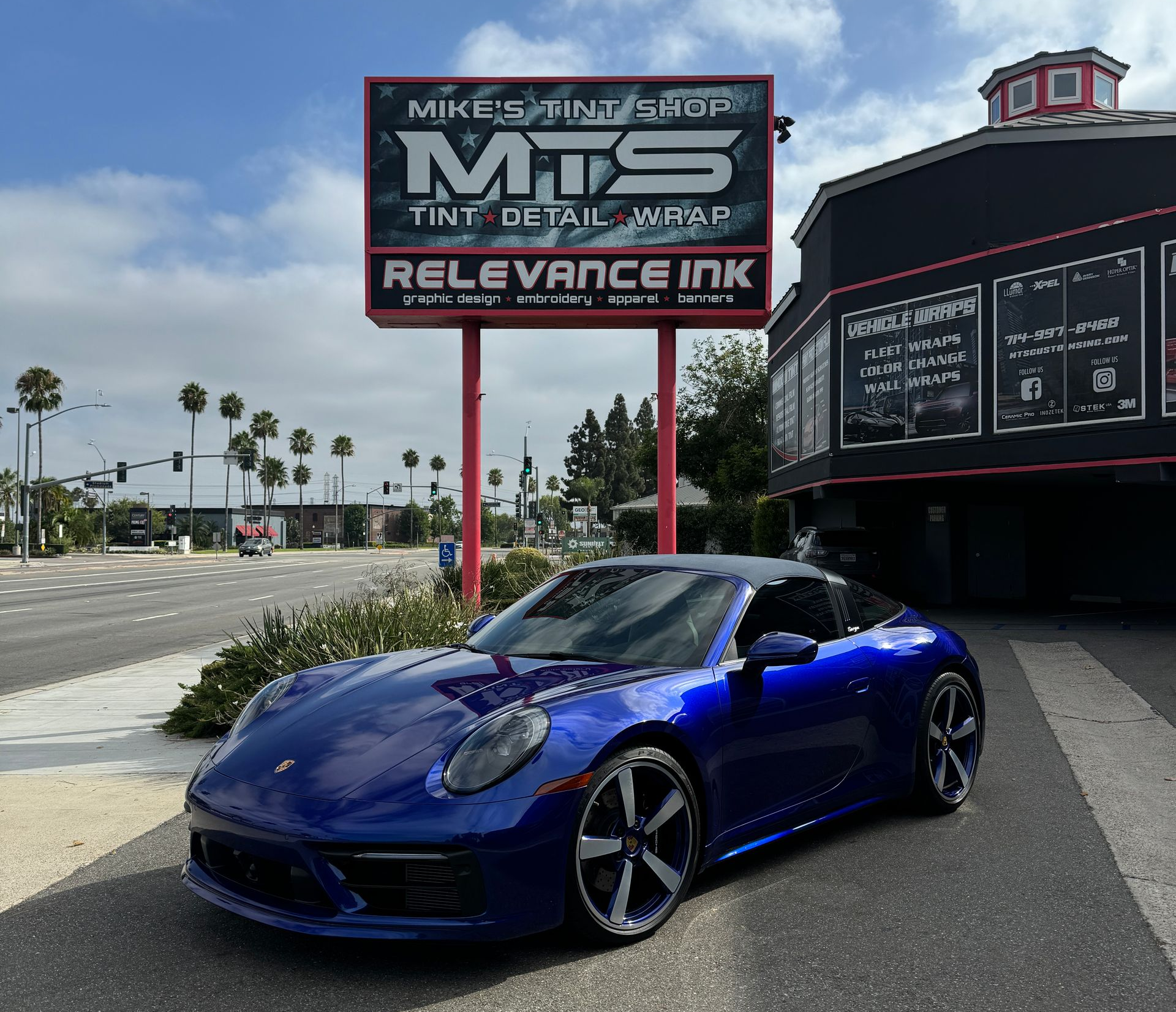
Advantages of Water-Based Solutions
Water-based ceramic coatings have earned their popularity largely because they strike a balance between performance and user-friendliness. Unlike their solvent-based counterparts, these coatings contain significantly fewer volatile organic compounds (VOCs), which means they emit far less harmful fumes during application. For anyone working in less ventilated spaces—or who simply wants to avoid respiratory irritation—the reduced toxicity is not just a convenience but a health safeguard.
This lower VOC content also translates into an eco-friendly appeal that more consumers demand today. As regulatory standards tighten around emissions, water-based products help you stay compliant without sacrificing the protective qualities expected from ceramic coatings. That’s why many professional detailers and even industrial applicators consider them an increasingly important part of their product offerings.
From practical experience at Mike’s Tint Shop, when advising customers or selecting coatings for jobs done onsite, I recommend water-based ceramics particularly for DIY projects or smaller-scale applications. Their quicker drying times—usually around 30 to 60 minutes—allow for faster turnaround without requiring specialized ventilation equipment. Plus, cleanup becomes a breeze since you can wash away residue using simple soap and water.
Another factor making water-based coatings popular is their safer handling profile. The risk of flammability is much lower compared to solvent-based products, which are often classified as flammable liquids due to the potent solvents they contain. This aspect reduces potential accidents significantly in workshops or home garages where sparks or open flames may inadvertently occur.
Beyond safety, water-based coatings tend to be easier on your skin and lungs during application, resulting in decreased incidents of irritation or headaches among users. This friendliness extends beyond application—disposal requirements are less stringent, reducing long-term environmental impact and permitting simpler waste management protocols.
Performance Considerations
Admittedly, water-based coatings generally deliver a slightly lower gloss level than some high-end solvent options, with typical readings around 70-85 Gloss Units compared to 85-95 Gloss Units achieved by solvent types. In terms of longevity, they usually protect surfaces for 1 to 3 years, which is suitable for most personal vehicles though might be shorter than the up-to-5-year durability solvent coatings provide under harsh conditions.
For many vehicle owners and detailing enthusiasts, this tradeoff is acceptable given the ease of application and health benefits involved. If your priority is straightforward maintenance without complex safety setups or strong odors lingering post-application, water-based ceramic coatings offer an excellent solution.
| Feature | Water-Based Coatings | Solvent-Based Coatings |
|---|---|---|
| VOC Levels | Below 50 g/L | Often exceeds 250 g/L |
| Drying Time | 30-60 minutes | 10-20 minutes |
| Flammability | Low (Class A or non-flammable) | High (flammable liquids) |
| Environmental Impact | Up to 80% less hazardous pollutants | Higher hazardous air pollutant output |
| Cleanup | Soap & water | Requires solvents |
| Longevity | 1 - 3 years | 2 - 5 years |
| Gloss Level | 70 - 85 GU | 85 - 95 GU |
Selecting between these two types of ceramic coatings hinges on your specific circumstances—whether that’s prioritizing environmental concerns, ease of use, or surface protection quality. Understanding these distinctions prepares you to make an informed choice aligned with your goals as we next explore how durability factors into your coating decision.
Durability and Longevity
Durability often takes center stage when choosing between solvent-based and water-based ceramic coatings. It boils down to how long you want the protection to last versus the effort you’re ready to invest in upkeep.
For instance, top-tier solvent-based coatings, such as CarPro CQuartz, are engineered to shield your vehicle’s paint for up to five years if maintained meticulously. But that longevity doesn’t come without its caveats; these coatings demand careful maintenance routines to keep their protective properties intact.
Maintenance for solvent-based coatings isn’t just a casual wash here and there. It involves using ceramic-friendly soaps, avoiding harsh detergents containing silica dioxide, and regularly decontaminating the surface. This prevents embedded contaminants from breaking down the coating’s integrity. Even the toughest coatings can degrade prematurely due to environmental aggressors like acid rain, tree sap, or abrasive polishes if neglected.
On the other hand, water-based coatings usually hold up for around one to two years—a shorter lifespan compared to solvent formulas—but make up for this with easier upkeep. These coatings respond well to regular maintenance sprays like HydrO2, which help replenish hydrophobic and UV protection properties without aggressive chemicals or extensive polishing.
Because they’re generally less rigid in application protocols and cleaning regimens, water-based options suit vehicle owners who prefer a “set it and remember it” approach combined with light periodic touch-ups.
What’s essential is recognizing that no ceramic coating lasts indefinitely without deliberate care. The protective layer naturally weathers over time due to constant exposure to sunlight, road grime, brake dust, and other contaminants.
To gauge whether it’s time to reapply your coating, observe some simple signs—loss of water beading where droplets flatten rather than roll off easily, increased difficulty removing stains from bird droppings or tree sap, or a dulling shine indicating diminished UV resistance.
A practical durability strategy involves combining visual inspections with straightforward tests like the hydrophobicity check—pouring water onto your car’s surface and watching how it behaves. When beads no longer form tight spheres but instead spread thinly across the paintwork, it signals coating wear.
Another useful tactic is applying an iron remover safe for ceramic surfaces; if this restores water beading by clearing iron contaminants clogging the pores of the coating, it means there’s still life left in it.
| Signs of Coating Wear | Maintenance Activities Extending Durability |
|---|---|
| Water beads flattening or lingering | Using only ceramic-safe soaps during washes |
| Loss of gloss or dull appearance | Avoiding abrasive compounds and automatic touchless car washes |
| Difficulty removing stains | Prompt removal of bird droppings, sap, and acid rain deposits |
| Regular application of replenishing sprays designed for coatings |
Understanding these factors shows that though solvent-based coatings offer unsurpassed longevity under perfect conditions, they require a higher degree of diligence. Meanwhile, water-based solutions may suit those seeking moderate durability alongside simpler upkeep, making your choice a clear matter of lifestyle and priorities.
At Mike's Tint Shop, we always encourage clients to balance performance expectations and maintenance habits before committing to any product. Achieving that balance not only protects your vehicle’s finish but ensures you get the best value over time.
Having explored how formulation impacts durability and care, we now turn attention toward mastering the nuances of applying these coatings effectively—timing, technique, and drying all play pivotal roles in achieving long-lasting results.
Application Techniques and Drying Times
Applying ceramic coatings isn’t just about slapping on a product; it’s a methodical process that directly influences how well the coating performs and lasts.
When working with solvent-based ceramic coatings, preparation is key. The surface must be impeccably clean and completely dry—any residual contaminants or moisture can interfere with bonding. Because these coatings contain stronger solvents, adequate ventilation is essential, and professionals usually recommend the use of respirators to avoid inhaling harmful fumes. The application itself typically involves using a lint-free microfiber applicator or foam pad to gently spread thin, even layers across the vehicle’s surface. Patience during this step matters, applying too heavily or unevenly can lead to streaks or compromised coverage.
In contrast, water-based ceramic coatings are more forgiving during the application phase. They still require a clean and dry surface but can tolerate minor imperfections better than their solvent-based counterparts.
Hobbyists often prefer water-based coatings because they have milder odors and are easier to handle in less ventilated spaces. Their user-friendly nature makes them ideal for DIYers who might not have the specialized equipment typically needed for solvent-based applications. Still, even with water-based products, applying thin coats evenly is important; taking your time prevents patchiness and ensures full protection.
Drying times between these two types also tell a story about how you schedule your detailing projects. Solvent-based coatings flash off quickly—typically within 5 to 10 minutes under controlled conditions, and become tack-free within around 15 to 30 minutes. This rapid curing allows vehicles to be driven within the next day or two but requires faster work during application as there’s less room for error once the coating begins to bond.
On the other hand, water-based coatings flash off slower, often needing 10 to 20 minutes or more depending on humidity and temperature, followed by tack-free periods extending up to an hour or beyond. While slower curing demands patience and careful environmental control, it reduces exposure risks and enhances ease of touch-up if necessary during buffing.
| Coating Type | Flash-Off Time (20°C, 50% RH) | Tack-Free Time | Full Cure Time | Notes |
|---|---|---|---|---|
| Solvent-Based | 5–10 minutes | 15–30 minutes | 24–48 hours | Fast drying; sensitive to humidity |
| Water-Based | 10–20 minutes | 30–60 minutes | 48–72 hours | Slower drying; more forgiving in application |
Another key aspect to appreciate is environmental sensitivity. Solvent-based coatings’ rapid flash-off means they can be prone to uneven curing if humidity spikes during application. This can compromise the chemical reaction that hardens the coating, so technicians often advise performing the job in controlled environments where temperature and humidity remain steady, usually between 15-25°C (59-77°F) with less than 60% relative humidity.
Water-based coatings handle fluctuations better but require longer cure times in cooler environments, potentially delaying vehicle use when conditions aren’t ideal.
Practical insight from industry pros at Mike’s Tint Shop emphasizes balancing speed with care: rushing solvent-based applications risks visible flaws, while patiently applying water-based coatings leads to consistent results even if curing takes longer.
Both types demand diligence but cater to different needs—professional detailers often lean toward solvent-based coatings for their fast turnaround and durability, whereas enthusiasts prefer water-based options for safety and ease without sacrificing much protection.
Mastering these application techniques and respecting drying time frames helps preserve a flawless finish longer while maximizing safety and performance under varied conditions—a crucial tip for anyone investing in high-quality ceramic coatings today.
Moving beyond application methods brings us naturally to consider how these coatings impact both health and the environment. Understanding these effects is critical for making responsible choices in protecting vehicles without compromising air quality or regulatory compliance.
Environmental Considerations
When it comes to ceramic coatings for vehicles, the environmental impact isn’t just a footnote—it’s a central issue shaping the market and your choices. Solvent-based coatings are often the go-to for many due to their durability, but they come with a hidden cost: high emissions of Volatile Organic Compounds (VOCs).
These VOCs contribute to air pollution and can harm both human health and the environment. Certain regions, such as California, have taken a strong stance on this by imposing strict regulations and steep fines for exceeding VOC limits.
If you’re running an autobody shop like Mike’s Tint Shop, choosing water-based coatings isn’t just about compliance; it’s about embracing sustainability while protecting your business from costly penalties.
Water-based ceramic coatings offer a compelling alternative because they reduce VOC emissions significantly, which improves air quality and worker safety inside your shop.
From personal experience, shops that have made this switch notice not only a lighter environmental footprint but also happier employees who no longer deal with harsh chemical fumes day in and day out.
Plus, these water-based formulations have evolved dramatically over the years—thanks to advances in nanotechnology, they now provide superb UV protection and hydrophobic properties that rival traditional solvent-based products.
This means you don’t have to sacrifice performance for sustainability.
Beyond regulatory compliance, adopting eco-friendly ceramic coatings aligns with growing customer awareness about environmental responsibility. Many clients actively seek services that minimize environmental harm, so offering water-based options can differentiate your autobody shop in a crowded market.
Moreover, using water-based coatings supports industry trends leaning toward bio-based polymers derived from renewable resources like corn starch or cellulose, further reducing dependency on petrochemical materials.
To put things in perspective: the global market for high-performance ceramic coatings is expected to exceed $33.88 billion by 2037.
Over the same time frame, the push for sustainability drives innovations like recycled glass additives and low-VOC formulas into mainstream use—ensuring that ecological benefits go hand-in-hand with technological advancements.
For any shop looking to future-proof its operations while meeting client demands and legal standards, gradually transitioning from solvent-based to water-based ceramic coatings makes sense.
It’s wise to train technicians on the subtle differences in application techniques between these coatings since water-based types may require slightly longer drying times or specific environmental conditions.
“Smart businesses invest in cleaner technologies not just because it's required—they do it because it’s good business.”
Balancing performance with environmental care isn’t just savvy, it’s essential in today’s automotive maintenance landscape. By prioritizing water-based ceramic coatings, your shop not only contributes to a healthier planet but also enhances its reputation as a responsible service provider prepared for the evolving future.
Understanding how these coating types affect long-term wear and upkeep naturally leads us to consider practical cleaning routines and maintenance strategies for optimal vehicle protection.
Cleaning and Upkeep
Maintaining a ceramic coating means understanding the subtle differences in how solvent-based and water-based products respond to cleaning routines. Solvent-based coatings are notably durable, often maintaining their protective layer through 50 or more wash cycles. However, this resilience comes with a trade-off: these coatings demand specific cleaning agents designed not to break down their chemical bonds.
For example, products like CarPro Reset or Gtechniq Panel Wipe are engineered to clean without stripping away the protective finish. Using harsh detergents or acidic cleaners can accelerate deterioration and compromise the coating's integrity.
To maximize the life of a solvent-based coating, it’s wise to schedule cleanings every two to three months using these specialized formulations. The process may take slightly longer because of the careful application required but yields long-lasting results and sustained hydrophobic properties that keep your vehicle’s surface gleaming.
Conversely, water-based ceramic coatings offer a friendlier experience when it comes to maintenance. Their lower chemical resistance means they require more frequent attention, usually every one to two months, to stay at peak performance. The good news is that you can clean them effectively with simple pH-neutral or mildly alkaline shampoos, avoiding any complex, chemical-heavy products.
This makes water-based coatings especially appealing for drivers willing to engage in regular upkeep without the need for special equipment or substances.
One trade-off, however, is their moderate resistance to water spots and occasional loss of hydrophobic qualities sooner than solvent-based coatings. But because maintenance sprays for these finishes are also water-based, upkeep involves straightforward applications that hobbyists find approachable and quick.
It’s important to remember that cleaning frequency isn’t just about aesthetics—it directly impacts protection. Dirt and contaminants allowed to build up can degrade the coating's surface, inviting premature wear or discoloration. Therefore, consistent care safeguards both appearance and longevity.
| Aspect | Solvent-Based Coating | Water-Based Coating |
|---|---|---|
| Cleaning Frequency | Every 2-3 months | Every 1-2 months |
| Compatible Cleaners | Specialized agents (CarPro Reset) | pH-neutral or mild alkaline shampoos |
| Durability After Wash Cycles | Maintains protection after 50+ | Protection begins fading ~30 cycles |
| Resistance to Water Spots | High | Moderate |
| Maintenance Spray Type | Solvent-based | Water-based |
| Cleaning Time per Session | Slightly longer | Faster |
For those seeking professional-grade application and personalized advice on cleaning schedules or product compatibility, Mike's Tint Shop offers exceptional service. Their expertise ensures coatings are applied correctly and maintained under ideal conditions tailored to regional climates and driving habits.
Final Thoughts
Choosing between solvent-based and water-based ceramic coatings comes down to matching the product to your lifestyle, vehicle use, and maintenance commitment. If you're driving a high-end luxury car or a prized Tesla through Orange County's intense sun and want that factory-finish look to last for years, solvent-based coatings deliver unmatched durability and gloss retention.
They're the gold standard for those who treat their vehicle as an investment and don't mind the more involved application process or specialized cleaning requirements.
On the other hand, if you value convenience, environmental responsibility, and a safer DIY experience without sacrificing solid protection, water-based coatings are an excellent choice. They've come a long way in performance and offer peace of mind for families and professionals who want their ride protected but prefer simpler upkeep.
At Mike's Tint Shop, we've been protecting vehicles in Orange, Riverside, and Corona for over 30 years. Whether you're leaning toward the long-lasting toughness of solvent-based coatings or the user-friendly appeal of water-based options, our certified technicians will guide you to the perfect solution for your vehicle. We don't just apply coatings, we protect your pride and joy with the same care we'd give our own rides.
Ready to give your vehicle the protection it deserves?
Book your free consultation today and let us help you choose the ceramic coating that fits your needs. Your car works hard for you, let's make sure it stays looking showroom-ready for years to come.
